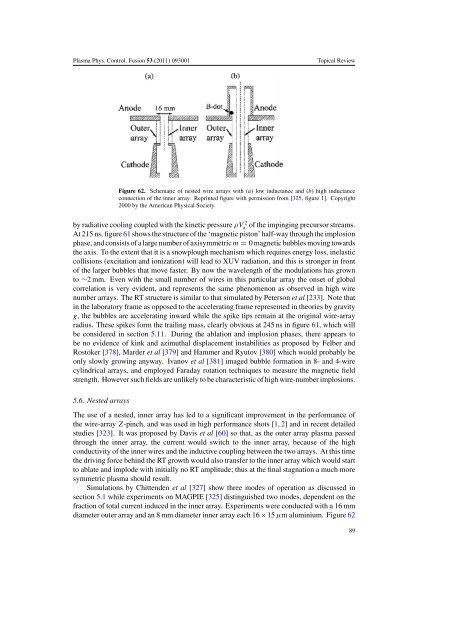You also want an ePaper? Increase the reach of your titles
YUMPU automatically turns print PDFs into web optimized ePapers that Google loves.
Plasma Phys. Control. Fusion 53 (2011) 093001<br />
Topical Review<br />
Figure 62. Schematic <strong>of</strong> nested wire arrays with (a) low inductance and (b) high inductance<br />
connection <strong>of</strong> <strong>the</strong> inner array. Reprinted figure with permission from [325, figure 1]. Copyright<br />
2000 by <strong>the</strong> American Physical Society.<br />
by radiative cooling coupled with <strong>the</strong> kinetic pressure ρVa 2 <strong>of</strong> <strong>the</strong> impinging precursor streams.<br />
At 215 ns, figure 61 shows <strong>the</strong> structure <strong>of</strong> <strong>the</strong> ‘magnetic piston’ half-way through <strong>the</strong> implosion<br />
phase, and consists <strong>of</strong> a large number <strong>of</strong> axisymmetric m = 0 magnetic bubbles moving towards<br />
<strong>the</strong> axis. To <strong>the</strong> extent that it is a snowplough mechanism which requires energy loss, inelastic<br />
collisions (excitation and ionization) will lead to XUV radiation, and this is stronger in front<br />
<strong>of</strong> <strong>the</strong> larger bubbles that move faster. By now <strong>the</strong> wavelength <strong>of</strong> <strong>the</strong> modulations has grown<br />
to ∼2 mm. Even with <strong>the</strong> small number <strong>of</strong> wires in this particular array <strong>the</strong> onset <strong>of</strong> global<br />
correlation is very evident, and represents <strong>the</strong> same phenomenon as observed in high wire<br />
number arrays. The RT structure is similar to that simulated by Peterson et al [233]. Note that<br />
in <strong>the</strong> laboratory frame as opposed to <strong>the</strong> accelerating frame represented in <strong>the</strong>ories by gravity<br />
g, <strong>the</strong> bubbles are accelerating inward while <strong>the</strong> spike tips remain at <strong>the</strong> original wire-array<br />
radius. These spikes form <strong>the</strong> trailing mass, clearly obvious at 245 ns in figure 61, which will<br />
be considered in section 5.11. During <strong>the</strong> ablation and implosion phases, <strong>the</strong>re appears to<br />
be no evidence <strong>of</strong> kink and azimuthal displacement instabilities as proposed by Felber and<br />
Rostoker [378], Marder et al [379] and Hammer and Ryutov [380] which would probably be<br />
only slowly growing anyway. Ivanov et al [381] imaged bubble formation in 8- and 4-wire<br />
cylindrical arrays, and employed Faraday rotation techniques to measure <strong>the</strong> magnetic field<br />
strength. However such fields are unlikely to be characteristic <strong>of</strong> high wire-number implosions.<br />
5.6. Nested arrays<br />
The use <strong>of</strong> a nested, inner array has led to a significant improvement in <strong>the</strong> performance <strong>of</strong><br />
<strong>the</strong> wire-array Z-<strong>pinch</strong>, and was used in high performance shots [1, 2] and in recent detailed<br />
studies [323]. It was proposed by Davis et al [60] so that, as <strong>the</strong> outer array plasma passed<br />
through <strong>the</strong> inner array, <strong>the</strong> current would switch to <strong>the</strong> inner array, because <strong>of</strong> <strong>the</strong> high<br />
conductivity <strong>of</strong> <strong>the</strong> inner wires and <strong>the</strong> inductive coupling between <strong>the</strong> two arrays. At this time<br />
<strong>the</strong> driving force behind <strong>the</strong> RT growth would also transfer to <strong>the</strong> inner array which would start<br />
to ablate and implode with initially no RT amplitude; thus at <strong>the</strong> final stagnation a much more<br />
symmetric plasma should result.<br />
Simulations by Chittenden et al [327] show three modes <strong>of</strong> operation as discussed in<br />
section 5.1 while experiments on MAGPIE [325] distinguished two modes, dependent on <strong>the</strong><br />
fraction <strong>of</strong> total current induced in <strong>the</strong> inner array. Experiments were conducted with a 16 mm<br />
diameter outer array and an 8 mm diameter inner array each 16×15 µm aluminium. Figure 62<br />
89














